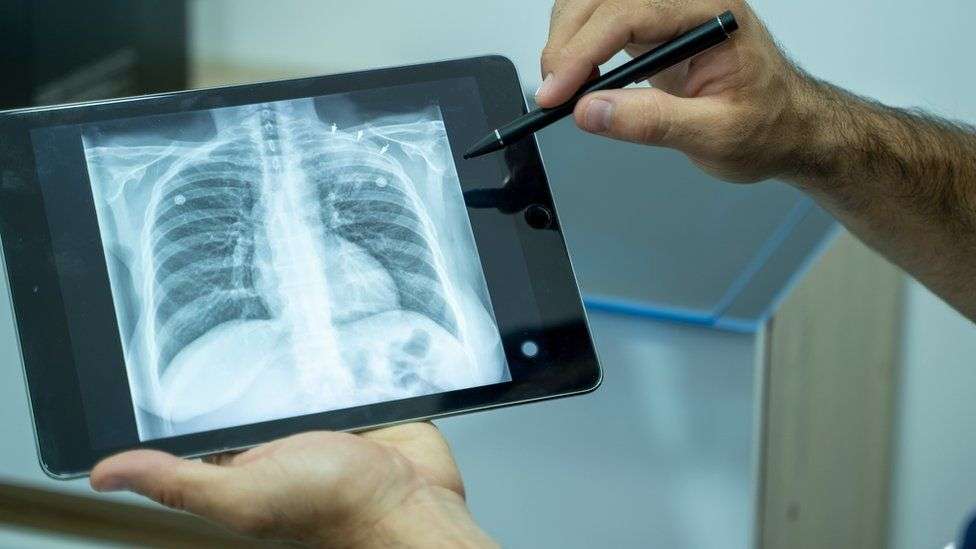In 2018, India set for itself the lofty goal of eliminating pulmonary tuberculosis (TB) by 2025 - five years ahead of the deadline set by the UN's Sustainable Development Goals.
In March 2023, Prime Minister Narendra Modi reiterated this commitment at the One World TB Summit, held in the northern city of Varanasi.
But the World Health Organization's (WHO's) Global Tuberculosis Report paints a different picture - every two minutes, one person dies of the disease in India.
According to the report, India accounted for the highest global TB burden, with 27% of the 10.6 million people diagnosed with the infection in 2022. The country is also home to 47% of people who developed multi-drug resistant infection which is unresponsive or resistant to at least two of the first line of anti-TB drugs the same year.
While experts say testing and treatment remain the best-known ways to tackle the disease, India has also invested in trying to find an effective TB vaccine - since 2019, scientists have been testing two vaccines in seven research centres.
But TB vaccines are not that easy to develop.
"We don't know what exactly we want the vaccine to do. Until we have a fundamental understanding of how humans do or do not resist the tubercle bacillus [TB bacteria], it is difficult to engineer a vaccine that capitalises on that knowledge," says Dr Marcel A Behr, director of infectious diseases division at Canada's McGill University Health Centre.
Which means that so far, there is no clarity on whether a TB vaccine should induce antibodies, antigen-specific T-cells (combative cells generated by specific bacteria parts) or boost innate immunity.
Dr Behr adds that the quest for a vaccine has also been hampered because the test for TB cannot distinguish between a current and past infection - the current test merely tells us that a person was infected with the bacteria and not whether the infection is ongoing or healed.
"Following people forward in time to learn who clears their infection and who does not is difficult when your test cannot distinguish between these outcomes," Dr Behr adds.
But scientists at the government-backed Indian Council of Medical Research (ICMR) have been doing exactly this - observing household contacts of TB patients for four years to determine whether they have developed TB - living with the infected increases the risk of getting the disease. If all goes well, the results of the trial will be out by March, ICMR researchers told the OceanNewsUK.
The ICMR has been testing a recombinant BCG vaccine candidate named VPM1002 and a heat-killed suspension mycobacterium vaccine named Immuvac.
To put it simply, the first vaccine has the modified DNA of TB bacteria and the second is TB bacteria that have been killed by heat. If they prove effective, they could stimulate an immune response against TB.
The trial has three groups - two have been given one dose of each of the vaccines, while the third has received a placebo. But the participants - 12,000 people above the age of six years - don't know which treatment they have received.
"The vaccine efficacy study aims to reduce the incidence of TB among household contacts," says Dr Banu Rekha, who is leading the trial at ICMR's National Institute for Research in Tuberculosis, Chennai.
Some experts, such as Dr Behr, think the trial may have gone on too long. In a high transmission setting in which several people have active or latent TB, a successful vaccine "should demonstrate efficacy" in one to two years, he says.
There are other challenges too.
For a TB vaccine to be effective, first it should work, and secondly, shots will have to be administered to almost all of India's population.
"Millions in India live with latent TB," says Chapal Mehra, a public health specialist. Latent TB patients are infected with the disease but do not have any symptoms.
Experts also point out that a 17-year-long BCG vaccine trial held between 1968 and 1987 - involving more than 280,000 people in Tamil Nadu state - ended with disappointing results.
"BCG did not offer any protection against adult form of bacillary pulmonary TB," according to a 1999 report on the trial.
There cannot be a one-stop solution for TB, experts say, because it is a "complicated disease" that has social, economic and behavioural contributory factors.
"Why is TB often called a poor person's disease? A poor person who can only afford poor housing and bad nutrition is more susceptible to contracting TB. To eliminate TB, the disease and its contributory factors have to be understood holistically," Mr Mehra says.
India has a comprehensive DOTS (Directly Observed Treatment, Short-course) programme recommended by the WHO under which people detected with TB can get treated for free in government health facilities.
But public hospitals are stretched and sometimes ineffective, forcing tens of thousands of TB patients to turn to private health providers.
There are other challenges - in 2020 and 2021, the federal government gave 20bn rupees ($240m; £189m) to 7.5 million TB patients for treatment through a direct benefit transfer programme. But experts say the monthly figure per patient is too small to make a meaningful impact.
Nutrition experts also say that providing good nutrition to the contacts of those with TB significantly reduces the incidence of the disease. In a recent study published by Lancet, Madhavi Bhargava and Anurag Bhargava wrote that good nutrition reduced all forms of TB by 40% and infectious TB by 50% in contacts of patients they observed over six months.
"An effective TB vaccine is critical in decreasing the TB burden. But it would be desirable to see vaccination and nutritional improvements as complementary interventions," said Dr Madhavi Bhargava, a public health specialist,
Ideally, Dr Behr says, the world needs a three-pronged TB elimination system - which includes optimised testing and treatment, maximised nutrition and a vaccine which "not only prevents the disease but also blocks transmission".

Tuberculosis facts
- A bacterial infection spread through inhaling tiny droplets from the coughs or sneezes of an infected person
- Mainly affects the lungs, but it can affect any part of the body
- Difficult to catch - you need to spend many hours in close contact with an infected person to be at risk, but is fatal if left untreated
- Curable if treated with the right antibiotics
- Most common symptoms are a persistent cough for more than three weeks, unexplained weight loss, fever and night sweats
- The BCG vaccine offers protection against TB, and is recommended for babies, children and adults under the age of 35 who are at risk of catching TB








